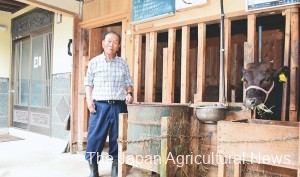| A traditional breeding system for Tajima-brand Beef in Mikata district (Kasumi Town and Shin-onsen Town) in Hyogo Prefecture was certified as a Globally Important Agricultural Heritage System in July. One of the factors the Food and Agriculture Organization of the United Nations (FAO) recognized was how local farmers raise cattle in a space at home called maya and treat the animals as if they are family members. A Japan Agricultural News reporter visited one traditional house with maya, where people and cows live together under the same roof.
The house is located in the mountainous village in the Kaijo region, Shin-onsen Town, which sits next to Tottori Prefecture and in the northwestern part of Hyogo Prefecture. It was about three hours by car from Kobe City. I was trying to ring the bell at the entrance when I saw two calves sticking their heads out from the wooden fence and grazing on hay. An 88-year-old farmer, Kiyomi Osaki, welcomed me and said, “This used to be normal for every farmer in this region.” Maya is a small cattle barn built under the roof of a farmer’s house, usually right next to the entrance. It’s like a big cage of about 7 to 10 square meters surrounded by walls and fences. Osaki’s house was built approximately 60 years ago. His house and maya are separated by a wall, so he can’t go directly to the barn from inside the house. But still, it’s called a house with maya as the house and the barn are under the same roof. Osaki has two breeding cows and two calves and grows rice in his 40-are rice paddy. He makes compost from cow manure for his paddy fields and feeds cows with the weeds he cut at his paddy. It’s a recycling-oriented agriculture system inherited for a long time in the region. He keeps his breeding cows on the pasture from June to October. He settles the cows in advance so that they give birth when they return to his maya in winter. After that, in June, he sends the cows back to the pasture and raises calves at home to put them on the market in summer or autumn. The Mikata region is a collection of many villages, mostly mountainous ones. “We have too little flat land to build cattle barns, so our ancestors began raising cattle under the same roof,” said Masanobu Noda, deputy director of the Tajima Cattle Museum in Shin-onsen Town, explained. “Then, through the life with cows at home, we have cultivated a culture of treating cows as if they are our family members.” Traditional farmers used to have furnaces dedicated to cattle at home to make hot water to keep cows warm in winter and to boil hay and straws so they were soft enough to eat, he added. According to Noda, there were around 4,000 houses with maya in the 1950s at the peak in the area called Mikata-gun today (excluding former Kasumi Town). However, after the 1960s, farming went more and more mechanized. Then, more and more farmers gave up raising cattle and maya disappeared gradually. Osaki’s house is the last one today. Osaki has lived with cows under one roof since he was born. “They are so adorable. I want to keep living with them,” he said. |
“Wagyu Olympics” which judges the excellence of branded cattle from all over Japan took place.
Watch and try to unveil the mystery of Japanese Wagyu. English, French and Chinese Subtitles are available (Spoken only in Japanese).-
Most Popular(Last 30 days)
- Number of young new farmers in Japan dips below 20,000 in 2018, fight over new workers with other industries gets severer 76 views
- ZEN-NOH completes lineup of Nippon Yell brand gummy candies from Japan’s all 47 prefectures 55 views
- Nagano successfully develops new pink, rich, crispy apple, expecting to discover new use 40 views
- It’s mysterious circles in Japan! Drone captures circles of trees 40 views
- 【News】 Convey your love with “sweetheart plants” (Feb. 6, 2014) 40 views
- 【News】 Fruit tree science institute releases new apple variety with pink flesh (Jan. 22, 2014) 38 views
- 【News】Mysterious tradition of Matagi Japanese traditional winter hunters inherited for generations (March 20, 2016) 35 views
- Japan’s southernmost winery created in Okinawa Prefecture 35 views
- Osaka earthquake shakes farm businesses in western Japan 33 views
- Neko-chigura cat cradles becoming increasingly popular among cats and cat lovers in Japan 33 views
Tags
Archive


